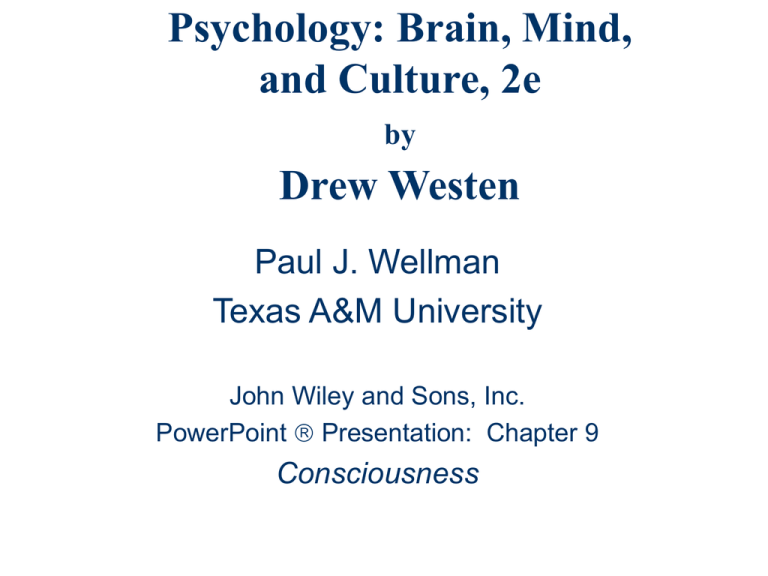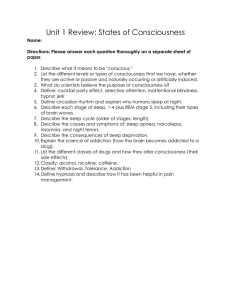
Psychology: Brain, Mind,
and Culture, 2e
by
Drew Westen
Paul J. Wellman
Texas A&M University
John Wiley and Sons, Inc.
PowerPoint Presentation: Chapter 9
Consciousness
Lecture Outline
Consciousness
Perspectives on Consciousness
Psychodynamic
Cognitive
Sleep and Dreaming
Altered States of Consciousness
Hypnosis
Drug-Induced state of consciousness
© 1999 John Wiley and Sons, Inc.
Consciousness
William James (1890):
Consciousness is a constantly moving stream
of thoughts, feelings, and emotions
Consciousness can be viewed as our
subjective awareness of mental events
Functions of consciousness:
Monitoring mental events
Control: consciousness allows us to formulate
and reach goals
© 1999 John Wiley and Sons, Inc.
Attention
Our conscious awareness is limited in
capacity and we are aware of only a small
amount of the stimuli around us at any one
time
Attention refers to the process by which we
focus our awareness
Three functions of attentional processes:
Orienting function
Control of the content of consciousness
Maintaining alertness
© 1999 John Wiley and Sons, Inc.
Sampling Day-Dreams in High
School Students
© 1999 John Wiley and Sons, Inc.
(Figure adapted from Csikszentmihalyi & Larson, 1984, p. 117)
Psychodynamic View of
Consciousness
Freud argued for three mental
systems within consciousness
Conscious: mental events that
you are aware of
Preconscious: Mental events
that can be brought into
awareness
Unconscious: Mental events
that are inaccessible to
awareness; are actively kept out
of awareness
© 1999 John Wiley and Sons, Inc.
Subliminal Perception
Notion that brief exposure to sub-threshold
stimuli can influence awareness
Study: subjects are shown aggressive (A)
or positive (B) stimuli
and then rate a neutral stimulus (C)
Subjects shown panel A rated the boy in panel
C more negatively
© 1999 John Wiley and Sons, Inc.
(Figure adapted from Eagle, 1959)
Unconscious Cognitive Processes
Information-processing view can be
extended to analyses of unconscious
processes
Notion is that many brain mechanisms
operate in parallel
• Some of these mechanisms operate outside of
consciousness
Functional significance of unconscious
mechanisms:
• Are efficient and rapid
• Can operate simultaneously
© 1999 John Wiley and Sons, Inc.
Sleep and Dreaming
Behavioral characteristics of sleep
Minimal movement
Stereotyped posture
Require a high degree of stimulation to
arouse organism
Physiological characteristics of sleep
EEG
EMG: paralysis of muscle
Cardiovascular changes
© 1999 John Wiley and Sons, Inc.
Species Variation in Sleep
© 1999 John Wiley and Sons, Inc.
Function of Sleep
Memory consolidation
Energy conservation
Preservation from predators
Restoring bodily functions
Sleep deprivation can alter immune
function and lead to early death
Sleep deprivation can also lead to
hallucinations and perceptual disorder
© 1999 John Wiley and Sons, Inc.
Mortality Rates and Sleep
(Figure adapted from Kripke et al., 1979)
© 1999 John Wiley and Sons, Inc.
EEG Stages of Sleep
(Figure adapted from Cartwright, 1978)
© 1999 John Wiley and Sons, Inc.
REM Sleep
Characteristics of REM sleep
Presence of rapid-eye-movements
Presence of dreaming
Increased autonomic nervous system activity
EEG resembles that of awake state (beta
wave)
Motor paralysis (except for diaphragm)
© 1999 John Wiley and Sons, Inc.
Dreaming
Psychoanalytic view: Dreams represent a
window into the unconscious
The latent content (meaning) can be inferred
from the manifest content (the actual dream)
Cognitive view: Dreams are constructed
from the daily issues of the dreamer
Biological view: Dreams represent the
attempt of the cortex to interpret the random
neural firing of the brain during sleep
© 1999 John Wiley and Sons, Inc.
Sleep Disorders
Insomnia: the inability to achieve or maintain
sleep
Many causes for insomnia
• Stress
• Depression
• Sleeping pills
Some suggestions for treating insomnia
• Only use your bed for sleeping
• Avoid physical activity prior to sleep
• Avoid consumption of caffeine and alcohol before
bed
• Keep a regular sleep schedule
© 1999 John Wiley and Sons, Inc.
Other Sleep Disorders
Nightmares: refer to vivid fear-evoking
dreams
Occur during REM sleep
Night Terrors: are episodes of intense
panic
Occur during delta sleep (early in night)
Sleep apnea: refers to awakening brought
on by cessation of breathing during sleep
Narcolepsy: falling asleep during the day
© 1999 John Wiley and Sons, Inc.
Altered States of Consciousness
Changes in consciousness can be
brought on by
Meditation
Hypnosis
Drug ingestion
Religious experience
© 1999 John Wiley and Sons, Inc.
Hypnosis
Hypnosis is a state of consciousness
characterized by
Deep relaxation
Suggestibility
Effects observed during hypnotic state:
Age regression
Change in pain perception
Ability to recall memories into consciousness
© 1999 John Wiley and Sons, Inc.
Changes in Pain Perception
during Hypnosis
Hilgard’s
demonstration of the
“Hidden Observer”
Subjective pain report
depends on the aspect
of consciousness that
is reporting on pain
(Figure adapted from Cartwright, 1978)
© 1999 John Wiley and Sons, Inc.
Drug-Induced States of
Consciousness
Drug effects on consciousness depend
on:
Biological activity of the drug
Expectations of drug effect
Drug classes
Depressants (including alcohol)
Stimulants (amphetamine, cocaine)
Hallucinogens (LSD)
Marijuana
© 1999 John Wiley and Sons, Inc.
Copyright
Copyright 1999 by John Wiley and Sons, New
York, NY. All rights reserved. No part of the
material protected by this copyright may be
reproduced or utilized in any form or by any means,
electronic or mechanical, including photocopying,
recording, or by any information storage and
retrieval system, without written permission of the
copyright owner.
© 1999 John Wiley and Sons, Inc.





